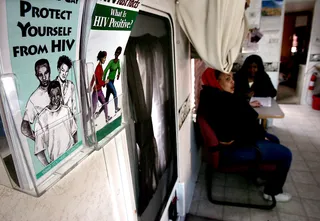National HIV Testing Day: Take the Test, Take Control
June 27 is National HIV Testing Day.

1 / 11
Taking Control - "Take the Test, Take Control" is the message behind National HIV Testing Day, observed on June 27. Created in 1995 by the National Association of People With AIDS (NAPWA), the initiative reminds Americans that knowing their status can save lives. With more than 1.1 million people living with HIV in the United States today — with the Centers for Disease Control and Prevention estimating that 20 percent of those people don't even know they're infected — BET.com wants you to know there’s no better time than now to know your status. —Britt Middleton (Photo: Wikicommons)

2 / 11
Disproportionately Affected - African-Americans have the highest rates of new HIV infections and deaths compared to all other racial and ethnic groups in the nation. While Blacks represented only 14 percent of the U.S. population in 2009, we accounted for 44 percent of all new HIV infections that year, the CDC reports. (Photo: GettyImages)

3 / 11
Empowering Message - Knowing your HIV status can help you take care of yourself. If you are diagnosed with HIV, you can receive medical treatment from a health care provider, and if you're negative, you can take steps to ensure you stay healthy. The CDC recommends everyone between the ages of 13 and 64 get tested for HIV at least once as part of routine health care. (Photo: ROBYN BECK/AFP/Getty Images)

4 / 11
Grim Reality - In 2009, the most recent statistics available, the CDC reported Black men accounted for 70 percent of the estimated new HIV infections among all Blacks. Black men who have sex with men represented an estimated 73 percent of new infections among all Black men, and 37 percent among all men who have sex with men. The rate of new HIV infections for Black men was more than six and a half times higher than white men and two and a half times higher than Latino men or Black women. (Photo: Justin Sullivan/Getty Images)

5 / 11
Who Is at Risk for HIV? - Anyone who has had unprotected sex, or who has injected drugs, or has had a partner who has done either of these things may be at risk for contracting HIV. (Photo: Spencer Platt/Getty Images)
Photo By Spencer Platt/Getty Images
ADVERTISEMENT

6 / 11
Black Women and HIV - In 2009, Black women accounted for 30 percent of the estimated new HIV infections among all Blacks, according to the CDC. The estimated rate of new HIV infections for Black women was more than 15 times that of white women, and more than three times that of Latina women. Eighty-five percent of Black women were infected through heterosexual sex. (Photo: Brent Stirton/Getty Images)

7 / 11
How Can I Reduce My Risk? - Latex condoms have proven effective in preventing the spread of HIV and other sexually transmitted diseases. Limiting your number of sexual partners or abstaining from sexual contact all together can greatly decrease your risk of becoming infected. (Photo: Brendan Smialowski/Getty Images)
Photo By Photo: Brendan Smialowski/Getty Images

8 / 11
How Do HIV Tests Work? - The most common HIV tests detect HIV antibodies, the substances the body creates in response to becoming infected with HIV. The amount of time it takes for the body to produce these antibodies can vary from person to person, but the CDC estimates that most people develop detectable antibodies that can be detected by the most commonly used tests in the United States within 2 to 8 weeks (the average is 25 days) of their infection. Ninety-seven percent of people develop detectable antibodies in the first three months. (Photo: Stephen Chernin/Getty Images)

9 / 11
Is There a Cure for HIV? - While there is no vaccine to prevent or cure HIV for those already infected, there are medications available that have helped many living with the virus live longer and more productive lives. (Photo: XINHUA/LANDOV)

10 / 11
Challenges in the Black Community - Stigma, fear and negative perceptions about HIV testing has helped fueled the alarming rates of HIV in the Black community. Knowing your status can protect your health and that of your partners. The CDC recommends getting tested at least once per year if you have had a new sex partner since your last HIV test, if you're having sex with someone infected with HIV or if you are engaging in other high-risk behaviors. (Photo: Spencer Platt/Getty Images )
